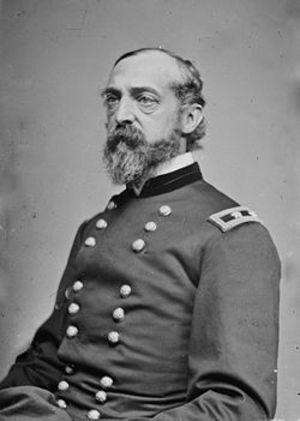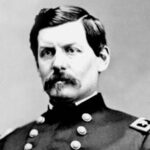In July of 1863, the Confederate Army of Northern Virginia, commanded by Robert E. Lee, marched north into Pennsylvania, closely followed by the Army of the Potomac, under George Meade. The battle that ensued at the strategic crossroads of Gettysburg marked the end of the Confederacy’s desire to fight and win a victory on Northern ground and gain international recognition. The battlefield today, thanks to the efforts of the National Park Service, remains in much the same condition as it was in the summer of 1863. For any student of military history, a visit (or three) to the field is a must. For Americans seeking an understanding of our history, Gettysburg remains a poignant and sobering lesson in conflict, sacrifice, honor and futility.
If you choose to visit the battlefield, be forewarned of a few things:
First, this is a huge park. Remember that the battle took place over three days; it was essentially three different battles fought in geographic proximity. It is possible to visit the entire battlefied in one day, but you will be pushing it.
Second, if you go in the summer, remember that this is also when just about everyone else visits the park. Fall and winter are actually good times to see the battlefield.
Finally, there is a lot to see and do in Gettysburg itself, just off the battlefield.
A primer for visiting Gettysburg:
First, rent and watch the movie. It is well done and especially if you have kids, will give them at least a bit of knowledge prior to setting foot on the ground. If you can, read the book on which it is based, “The Killer Angels” by Michael Shaara.
Second, figure out what everyone wants to do and see: Once you get away from the tourist traps just outside the Visitor Center, there are some nice antique shops, restaurants and even a golf course nearby.
Third, decide where you want to stay if you spend a night or two and make your reservations well in advance. There are some really nice old hotels and bed and breakfasts in the downtown area; the more modern (and noisier) hotels are near the Visitor Center. Ghost tours are also very popular; more on that later.
Finally, take your bicycles. If there was ever a place that is best seen from a bike and it is safe, it is the Gettysburg battlefield.
On the day of your visit, take the extra time in the morning to go to the Visitor Center. It is well worth your time to spend about an hour going through the exhibits and seeing the maps. Remember that you can always come back to the gift shop and the book store. Get a Visitor map and guide and then get going.
Follow the battlefield as the NPS map recommends; it will take you through the battle chronologically, starting with the cavalry fight on McPhersons Ridge. This fight ended with the routing of the initial Union forces on the field and their retreat to Cemetary Ridge. The next portion of the tour takes you to the Confederate positions on Seminary Ridge. Resist the urge to stop and do Picketts Charge, that will come later. Continue on to Little Round Top as this was the center of the second days fighting and the scene of Chamberlain’s bayonet charge. Once you leave here, you will have the option of taking the long tour which includes Culps Hill. If you can, I recommend that you do so. For you ghost hunters, Spangler’s Spring is supposedly haunted; this portion of the field, although not visited as frequently by most people, was the scene of heavy fighting on the second day.
Once you leave Culps Hill, you go back to the scene of the final charge (it was really Longstreet’s, not Pickett’s) at the copse of trees on Cemetary Ridge. Spend some time here and walk the line. Now, it is time to put yourself in that time and place. Go back to the Seminary Ridge side of the battlefield and have someone in your party drop you off at the Virginia memorial. Walking Pickett’s Charge is a guaranteed highlight. Walking that mile over open ground, it is easy to imagine yourself clad in butternut, carrying a musket, knowing that 1 out of every 2 soldiers would be hit or killed.
Join up with your driver at the Union position. Now, you have some choices to make. This will pretty much eat up an entire day; but if you go in the summer, you have a chance to go the East Cavalry Battlefield, which almost no one visits. If you stay a second day, this trip is a must, but it is a good twenty minute drive outside of town. This fight was George Custer’s first stint as a cavalry general and is famously recreated in “They died with their boots on.” If you decide not to go on, a visit to the book store or even some of the tourist traps is worth your time, believe it or not.
For you ghost hunters, Gettysburg is a must. But be forewarned, there are nearly as many visitors after hours at night as there are during the day. There are organized ghost tours of the downtown area as well as some of the battlefield sites. The NPS seems to be fairly forgiving of people on the field after the sun goes down, but I wouldnt push it. Yes, I have my own story: I was riding my bike in the vicinity of General Sedgwicks headquarters just after sundown on a deserted road and smelled cigar smoke; there was no one else around.
On the subject of biking; biking the battlefield early in the morning is a great exercise and with not many cars, it is very safe. Even during the day, biking is a great way to see the battlefield as a commander on horseback might have seen it. Generally, everyone driving is doing so fairly slowly, so again it is very safe.
Gettysburg is located about an hour north of Washington DC, just off Route 15. For those of you feeling really ambitious, there are several other battlefields within an hours drive of Gettysburg, including Antietam, Monocacy and Harpers Ferry.



